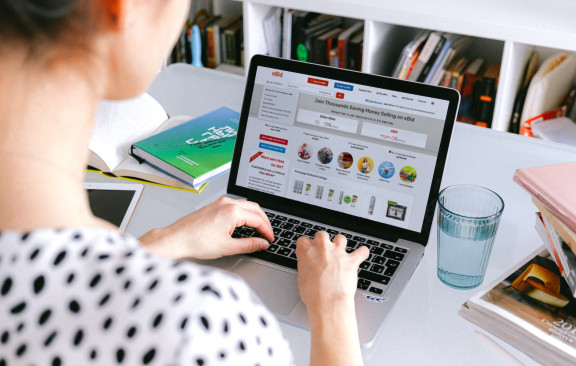Typography is one of the most important and most neglected elements in web design. Simply put, typography is the art of selecting the fonts you use on your website, Facebook page, and social media communications.
Entrepreneurs and e-commerce store owners need to pay careful attention to typography. There is a lot of research that indicates that the typeface consumers see can have a great deal of influence on their behavior.
In one interesting example, The Journal of Consumer Psychology, researchers found the choice of font affected readers’ ability to remember advertising copy and the claims it made. You need to be aware of this extra boost so that customers will remember your product and brand!
How typography influences behavior
Typography has also been found to influence the way consumers perceive a brand and think about it. In a historically cited paper in The Journal of Marketing Research, Jennifer L. Aakker noted that a particular font made consumers more likely to believe Wendy’s (an American hamburger chain) claim of serving “old-fashioned” hamburgers.
Your choice of font type and size is vital in the world of e-commerce, because the written text is the primary communication between a merchant and a potential consumer. The text establishes brand personality, which can determine how the consumer views the product or retailer and how likely he or she is to make a purchase.
Typography has also been found to influence how consumers feel about a product or brand. Colors, in particular, can have a strong influence on readers’ emotions. For example, red’s ability to stimulate appetite is well-documented. Professor Judy Zaichkowsky, of Canada’s Simon Fraser University, noted that many food brands, including Kit-Kat candy bars, use red to stimulate purchasers.
So, it seems to be a wise choice to use a red typeface for a food product. But it would not be appropriate in a website for sleepwear, because the color conveys action and excitement.
Now you know why red is often used in signs (think of a stop sign) or sales advertisements. The idea is to develop a sense of urgency in the customer and encourage a quick decision.
Other examples of colors that can influence consumer behavior are black, which is perceived to be bold and decisive, and grey, which is felt to be neutral and passive. Pink and blue are both relaxing, while purple is often associated with authority or power.
The basics of good typography
Here are the three basic factors that determine the effectiveness of a typeface: legibility, readability, and context.
Legibility
Legibility refers to the readers’ ability to easily comprehend the letters or characters. Some typefaces, such as Tahoma and Arial, are more legible than others. These simple fonts are legible and more useful in online material.
Elaborate, decorative fonts and scripts are less legible. Many e-commerce sites try to look fancy by using an ornamental font that is not legible. Even some widely used fonts, such as Times New Roman, might not be legible in certain circumstances (especially when the font size is on the small side).
A good guideline to follow is this: sans serif fonts (fonts with no “feet”, such as Arial, are more legible than serif fonts, such as Times New Roman.
You will connect better with your customers and keep your website copy legible by using one basic font in all your communication. Having two or three different typefaces on the same page will dramatically decrease legibility.
Legibility is affected by a number of factors, including the size of the font, the background colour, the space available, and other images on the page. These design factors all influence readability.
Readability
Readability refers to the design factors that affect the readers’ ability to understand the writing. A successful webpage will utilize a typeface that enhances readability by making the copy as easy to read as possible.
Here are several factors that can influence readability:
- Type size.
- Type color.
- Spacing between words or letters.
- Spacing between lines.
- Background color (white is usually the easiest to read).
- Layout of the copy; words printed in a straight line are easier to read. Large blocks of copy are harder to read.
- Images and other design elements that distract from the copy, such as photographs or logos.
Bold, black type might offset an image that distracts the reader. A red or blue background might make white type hard to read. A color that blends in with the background might decrease readability.
Red type on a red or black background will not read effectively. Red type on a white background is both bold and decisive. Blue type on a red background could confuse the reader.
Context
Context is a basic design element that many sellers forget about. The main factor in determining context is choosing an appropriate font. You can determine this by considering the objective of your copy and the emotions that you want to evoke in readers.
To elaborate on the importance of context, here is a section from a very entertaining article on Next Day Flyers regarding the Comic Sans font:
“Restaurant signs will never look very sophisticated in Comic Sans, and a résumé set in Comic Sans isn’t going to impress many CEOs. But the mark of good design is design that works when and where it needs to — even if it’s for just one short moment”
Color also plays a big role in context:
- Red or black text and large letters can indicate action or urgency. So they’re appropriate for a banner ad. Yet such colors are inappropriate if you are trying to instill a sense of comfort in your readership — blue might be better.
- The color pink can evoke a feeling of ease, but it also has some potentially controversial connotations. Some people associate pink with weakness or softness and with certain political stances.
- Yellow evokes light and a sense of relaxation, because of its association with the sun.
- Orange is sometimes associated with financial institutions and discounts because of its connection with gold.
- A gold color is often associated with wealth, power or quality. Yet many people consider it to be gaudy or ostentatious.
Decorative fonts might be seen as formal and as adding prestige to your copy, yet be careful, because they can be seen as ostentatious as well. A decorative font might be appropriate in an advertisement for antiques, but probably not in an ad for a new smartphone.
Keep these factors in mind when choosing a font for an e-commerce project. The best-written copy will not attract people if it cannot be read or understood. You want to have your typography stand out for your website, Facebook page, and all your social media communication.
Remember that you want to exert a positive influence on the readers’ actions and emotions. When they feel good about what they see and read, they’re more likely to take the next step and click the Buy button!











